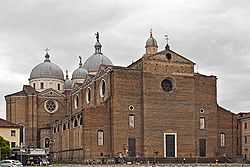Abbey of Santa Giustina
| Abbazia di Santa Giustina | |
|
Basilica of St. Justina | |
| Monastery information | |
|---|---|
| Order | Order of St. Benedict |
| Established | 10th century |
| Dedicated to | St. Justina of Padua |
| Diocese | Padua |
| Abbot | Francesco Trolese, O.S.B. |
| Architecture | |
| Heritage designation | National monument |
Coordinates: 45°23′47″N 11°52′47″E / 45.39639°N 11.87972°E The Abbey of Santa Giustina is a Benedictine abbey in the center of the City of Padua, facing the Prato della Valle, which dates from the 10th century. The abbey is attached to the Basilica of Santa Giustina, which was built in the 6th century. Its present shape derives from construction in the 17th century.
History
The abbey is attached to the basilica which was built in the 520s by the Prefect Opilius to house the remains of St. Justina of Padua (d. 7 October 304) and of other Christian martyrs of the city. The building, with its lavish decorations, was described in 565 in a Life of St. Martin written by Venantius Fortunatus. By the 10th century, the presence of a monastic community which served the many pilgrims who came to the basilica to pray to the saints whose relics were contained there is seen in the decision of the Bishop of Padua in 971 to place the community under the Rule of St. Benedict.[1]
At that point the monastic community undertook renovations of the basilica. In the course of this work, on 2 August 1052 the remains of various saints, including Maximus the Confessor, Felicitas of Padua, Julian the Hospitaller and those identified as the Holy Innocents, were exhumed. In 1110 the abbey was sacked by the troops of the future Holy Roman Emperor Henry V during his invasion of Lombardy, in order to punish the monks for their loyalty to Pope Pascal II. The basilica complex was devastated in 1117 by a massive earthquake which wreaked havoc throughout northern Italy and Germany. After the basilica and monastery were rebuilt, excavations resumed and in 1174 the remains of the patroness of the abbey was discovered, as was those identified in 1177 as those of Luke the Evangelist.<ref name=S2 /[2]
A period of decline in the observance of its way of life began to develop in the monastic community. At the same time, the monks were led by a number of very spiritual abbots, such as Arnaldo of Limena, who died while imprisoned by Ezzelino III da Romano and is honored as "Blessed", as is Nicholas of Prussia. The abbey, however, reached the height of its influence under the leadership of Ludovico Barbo, who, despite being a canon regular and not a monk, was appointed as abbot by the bishop in order to undertake a reform of the monastic life in the abbey. He was successful and the abbey became the nucleus of the Congregation of Santa Giustina, which spread to include monasteries throughout Europe who came under the guidance of the Abbot of Santa Giustina. The congregation later became called the Cassinese Congregation. The abbey developed ties with centers of learning across the continent.[3]
The life of the abbey came to an end in 1797 when, along with all other religious communities, it was suppressed in the occupation of Italy by the French Revolutionary Army, led by Napoleon Bonaparte, which established the Cisalpine Republic in the city. Its artworks and the most valuable collections of the abbatial library were sent to Paris by the occupying forces. The monks were expelled and the buildings and property were sold off in 1810. The cloisters were then used as a military hospital, later as a barracks.[3]
The buildings were returned to the Catholic Church in 1917 and Pope Benedict XV re-established the abbey with all its ancient rights and privileges. He placed it under the Abbey of Praglia in nearby Teolo, which sent monks to resume monastic life there. On 1 November 1942 the community was declared an autonomous priory, which was established under its own abbot on 22 January 1943. The basilica and abbey now have the government status of a national monument and operate under the authority of the Superintendent of Monuments and Civil Heritage.[3]
Artwork
.jpg)
The basilica church, with a profusion of Byzantine domes, was known for its diverse relics. The church contains the Martyrdom of St. Justine by Paolo Veronese.
The belltower has 8 bells in B.
